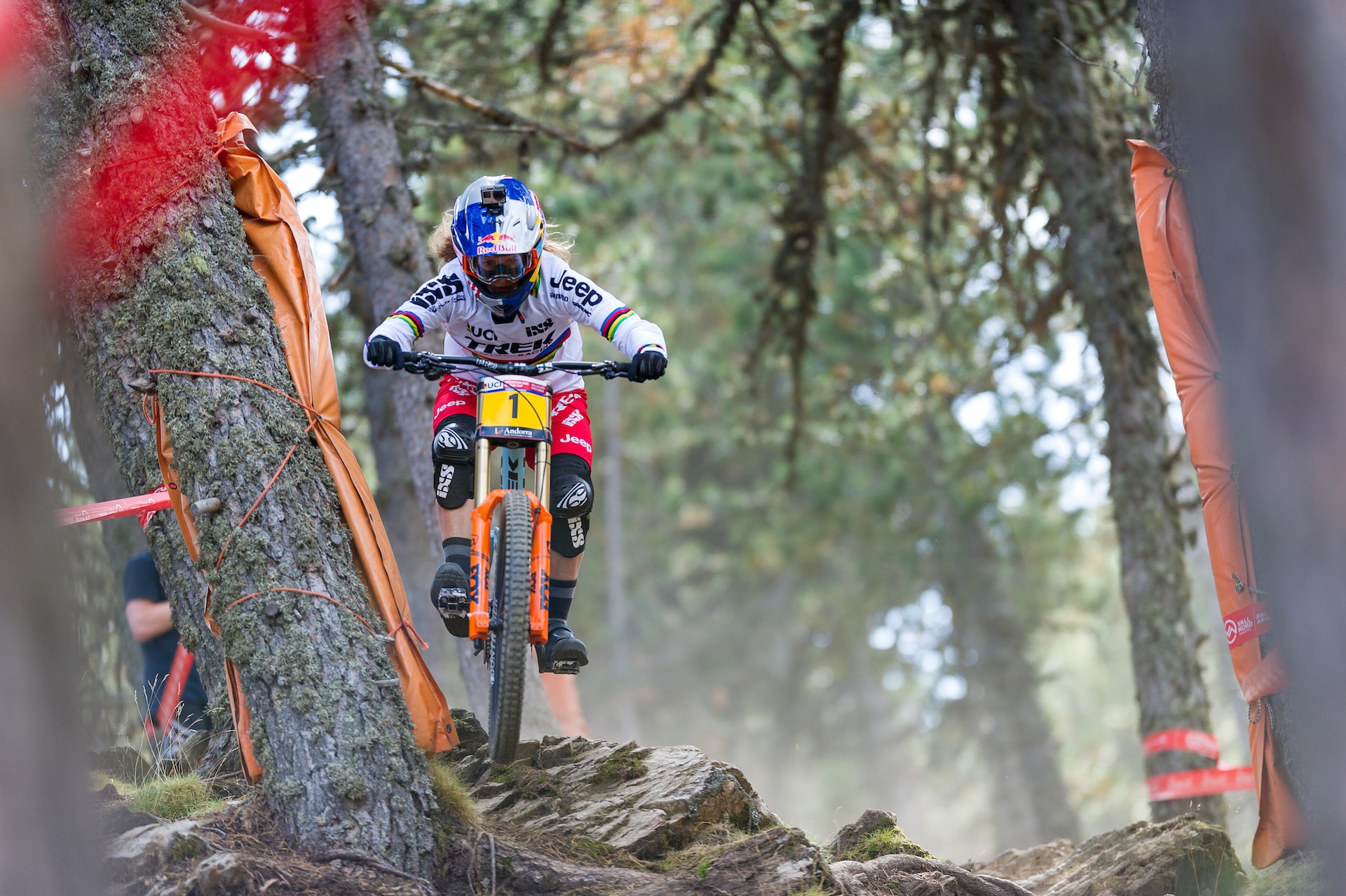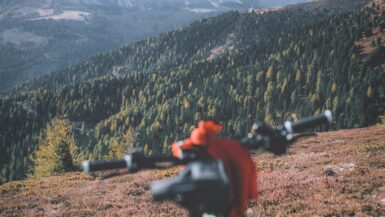Mountain biking through uneven terrain can be a thrilling experience. It requires navigating various surface types, from rocks to loose dirt, roots, and mud. By learning the correct techniques and building your skills slowly, you can master the art of mountain biking through uneven terrain. In this article, we’ll look at how to ride a mountain bike through these conditions safely and confidently. We’ll also provide tips for avoiding common mistakes and staying in control. Whether you’re a beginner or a seasoned rider, these techniques will help you traverse uneven terrain easily.
Preparing to Ride
When riding a mountain bike on uneven terrain, it is crucial to have suitable materials. First, you will need a properly fitted mountain bike. The bike should have a lightweight frame and wide tires with deep treads. Additionally, ensure that your bike’s brakes, suspension, and shocks are correctly working. It is also necessary to wear protective gear. This includes a properly fitting helmet, gloves, and athletic shoes or cleats. Keep a water bottle or hydration pack on hand for additional hydration as needed.
Practice Biking Basics
Before you embark on a journey across uneven terrain, brushing up on your biking basics is essential. This includes learning to shift gears properly, brake, and turn the bike. To bike on uneven terrain, you should become comfortable anticipating hills, dips, and ruts. Additionally, it would help if you were satisfied with steering while standing up and being able to lean your body weight in the direction you are turning.
Learn About the Course
If possible, it is beneficial to research the terrain that you will be biking on. Know what terrain type to expect and if there are any specifically challenging portions. Additionally, be aware of potential danger spots, such as loose rocks or tree roots. Find out what types of trails are available and how difficult they are. If possible, try to practice on similar terrain to get a feel for what you will encounter.
Condition Your Body
To ride a mountain bike on uneven terrain, you must have excellent physical condition. This means staying active and engaged in regular physical activity. Regular exercise strengthens your muscles, increases your stamina, and can help reduce the risk of injury. Additionally, it is vital to stay hydrated during any physical activity.
Plan Your Route
Planning a route is crucial in ensuring a safe and successful ride. Choose a course that you are comfortable with and can handle. If possible, stick to trails that are marked or that you are familiar with. Avoid any areas that may be too difficult for your skill level. Additionally, include rest stops along your route or even bring a companion for better safety.
Confidence and Patience
When riding a mountain bike on uneven terrain, it is essential to stay patient and confident. Be sure to take deep breaths as you encounter tricky patches to remain focused and conscious of your surroundings. Additionally, don’t forget to enjoy the ride and the unique scenery that comes with it.
Maintaining Control
Riding a mountain bike on uneven terrain requires riders to stay alert and watch for obstacles, terrain changes, and other cyclists. While focusing on the trail ahead, riders should also be aware of their surroundings. This includes awareness of other bikers, vehicles, pedestrians, and potential hazards. Being aware of the surroundings will help riders anticipate and react faster in certain situations and keep riders safer while riding.
Focus on Balance and Speed
To stay in control while riding a mountain bike on uneven terrain, riders should focus on their balance and speed. Technically, controlling the bike’s speed should come first, as avoiding obstacles is more important than going faster. However, maintaining a good balance is also essential for a smooth ride. When navigating challenging obstacles, riders should keep their center of gravity low and the bike upright to prevent losing control.
Staying in Control When Ascending and Descending
Changing elevation is a standard part of mountain biking. When ascending, riders should choose the best line and engage their entire body to pedal, keeping their elbows slightly bent to maintain good posture. When descending, riders should keep their upper body low, their feet on the pedals, and their eyes on the terrain ahead. Both ascending and descending require riders to maintain their weight balance and control their speed to ensure a smooth and safe ride.
Mastering Techniques
To become an expert mountain biker, riders should regularly practice proper technique and skills. This includes mastering joint mountain biking maneuvers, such as cornering, shifting gears, and braking. Keeping the bike’s weight balanced while performing these maneuvers is essential for maintaining control. Furthermore, riders should stay aware of how their body is positioned and how their bike reacts to the terrain. With proper practice and dedication, riders can gain the skills and control needed to navigate any landscape confidently.
Shifting Gears
Mountain biking on uneven terrain requires riders to constantly adjust their body position to maintain balance and control when shifting gears. When approaching a section of rough terrain, it is vital to lower your center of gravity by bending your elbows and knees and keeping your arms and legs relaxed. This will ensure that you stay on the bike and can anticipate changes in the terrain, such as bumps, dips, and jumps in the trail.
Choose the Right Gear
When navigating uneven terrain, it is essential to choose the right gear to ensure you have adequate power to climb hills or accelerate on flat or downhill sections. Using moderate gear when riding over rough terrain is vital, as it will give you more control and make it easier to remain balanced. Before tackling a section of rugged terrain, it is critical to shift into the appropriate gear to focus on maneuvering and balance rather than shifting gears.
You’re in Control
Always remember to keep your body loose and relaxed and to stay in control of your bike while adjusting to the terrain. If you are pedaling too quickly or unable to shift gears, stay in control and slow down. This will help you remain balanced and keep your momentum while traversing the uneven terrain.
Conserve Energy
Conserving energy is critical to successfully maneuvering rough terrain. It would help if you focused on pedaling smoothly and taking an efficient line. Try to anticipate changes in the landscape and adjust your body and gear selection as necessary. This will help you conserve energy and make your ride smoother as you navigate the terrain.
Be Prepared for Obstacles
When riding over uneven terrain, it’s essential to be prepared for obstacles such as rocks and roots. Try to maintain your momentum, stay in control, and avoid sudden movements or braking. Always be sure to look ahead and anticipate changes in the terrain so that you can adjust your speed and gear selection accordingly.
Uneven Techniques
Rock gardens are one of the most challenging and exhilarating sections of off-road trails. They consist of rocky obstacles, often arranged in an undulating line.
There are two main techniques for riding rock gardens. The first is the “pump and jump” approach, which involves using your body weight and speed to bounce off and over the rocks. This requires timing and control, as you must adjust your body position quickly to overcome obstacles.
The second technique is the “flow” approach, where you ride the rocks in a more controlled manner by maintaining your speed, keeping your weight centralized, and looking ahead to identify the best line. This allows you to maintain more control over the rocks but requires more skill and experience to master.
Managing Uneven Surfaces
Another technique for riding uneven terrain is managing uneven surfaces. This involves anticipating bumps, rocks, tree roots, and other rough terrain and adjusting your riding technique accordingly.
To do this, you need to focus on your line of sight and body position. Choose a clear line of sight and keep your arms, legs, and back relaxed to react quickly to the changing terrain. It would help if you also looked ahead and kept your eyes focused on the trail so you could spot the next obstacle or adjust your line accordingly.
Braking and Cornering Techniques
When riding uneven terrain, it’s crucial to brake and corner effectively. To do this, you must adjust your speed to the landscape and use your brakes sparingly. Use your body weight to steer your bike through corners, and keep your arms, legs, and back relaxed so you can control your balance and direction.
Additionally, it would help if you used the terrain to your advantage. For example, if you come across an uphill section, you should use the additional traction of the uphill to help you slow down.
Navigating Obstacles
Navigating obstacles is an essential skill for riding uneven terrain. This includes logs, rocks, drops, and other technical features. It would be best if you took your time to assess the obstacle and choose the best line.
You should approach obstacles with large drops at an angle and lean back to keep your body centered. Using your momentum for larger logs and rocks would be best to help you roll over the obstacle.
Finally, you should always be prepared for the unexpected. When riding uneven terrain, you should always be aware of your surroundings and ready for surprises.
Checking and Maintaining Your Bike
Mountain biking is an exhilarating experience that requires the confident handling of uneven terrain. To ensure a safe and enjoyable ride, checking and maintaining your bike before every ride is crucial. Here are some essential tips for keeping your bike for riding over uneven terrain.
Inspect Your Bike
Before each ride, it is vital to inspect your bicycle for any loose, damaged, or worn components. Start by carefully examining the wheels, tires, and brake systems. Make sure that all moving parts are properly lubricated and that there are no damaged components. You should also check the brakes and confirm that they are working correctly.
Adjust Your Bike’s Settings
It is essential to adjust your bike’s settings for varying terrain to ensure optimal performance. Changing the air pressure of the tires for different rides is recommended, as lower air pressure allows for better traction in softer terrain. You should also adjust the seat height, stem length, and handlebar width for a better riding experience.
Clean and Lubricate Your Bike
Properly cleaning and lubricating your bike will help to prevent premature wear and tear. Start by cleaning the frame, fork, and drivetrain components with water. Make sure to use a gentle detergent and a soft, bristled brush to scrub away any dirt or debris. After cleaning, it is essential to lubricate all moving parts, including the chain, drivetrain components, and cables.
Regular Tune-Ups
Regular tune-ups should be performed to maintain optimal performance and safety of your bike. You should bring your bike to a professional mechanic at least once a year for a complete tune-up. This will ensure that all components are correctly inspected and adjusted to manufacturer specifications.
Following these essential tips ensures that your bike is in peak condition and ready to tackle uneven terrain. You can have an enjoyable and safe ride with proper care and maintenance.
Safety Tips
Before you begin your mountain biking expedition:
- Prepare your bike, gear, and yourself for the uneven terrain ahead.
- Inspect your bike thoroughly, checking that all its components are functioning correctly.
- Make sure your bike has the right tires for the landscape, and consider replacing them if worn out.
- Check that you have the right protective gear, including a helmet, eyewear, gloves, and any other protective gear you deem necessary.
Keep Your Eyes Ahead
When you are out mountain biking, always keep your eyes ahead so you can anticipate any upcoming obstacles. Staying focused on what lies ahead will help you better prepare for the terrain. Keep your body position and weight in line with the bike, making it easier to maneuver on uneven terrain.
Choose a Low Gear
When traveling on uneven terrain, choose low gear for any uphill climbs. This will make it easier to maintain control and help you climb even the steepest hills. When you reach the top, make sure to shift back into a higher gear before you start heading downhill.
Safety Tips
When traveling on uneven terrain, always practice safety first. Wear protective gear, such as a helmet and eyewear, and ensure that you are familiar with the trail before starting your ride. Obey all traffic signs and take breaks if needed. Also, stay hydrated and keep a fully stocked first-aid kit in an emergency.
Mastering the Art of Mountain Biking
Riding a mountain bike through uneven terrain can be a tricky task. If you are new to the sport, you should start with easier terrain until you get a good feel for the bike and become comfortable with the balance and speed. You should also wear protective gear, such as a helmet and knee pads, to stay safe in a crash. As you progress to the more challenging terrain, you must remain alert and plan your route. You should always keep your weight centered over the bike, use your brakes as needed, and be prepared to shift your balance significantly. With practice, patience, and proper technique, you can soon be an expert in riding a mountain bike through uneven terrain.






Leave a reply